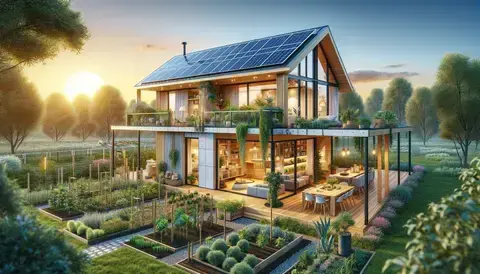Healthy Sustainable Housing
Free 2024 Healthy Sustainable Housing Course

Introduction
Welcome to our comprehensive course on Healwill delve into the history, characteristics, and future trends of sustainable housing, providing a holistic understanding ofthy Sustainable Housing. This course aims to equip learners with in-depth knowledge and practical skills to understand, evaluate, and implement sustainable housing practices globally. By exploring various regions and their unique approaches, we this vital field.
What is Healthy Sustainable Housing?
Understanding Healthy Sustainable Housing
Healthy sustainable housing refers to homes designed and built to promote the well-being of their occupants while minimizing environmental impact. These homes integrate eco-friendly materials, energy-efficient systems, and designs that support healthy living environments.
Definition and Core Principles
Healthy sustainable housing is based on several core principles:
- Eco-Friendly Materials: Using materials that are sustainable, non-toxic, and have a minimal environmental footprint. Examples include bamboo flooring, recycled wood, and non-toxic paints.
- Energy Efficiency: Incorporating renewable energy sources like solar panels, and ensuring the home is well-insulated to reduce energy consumption.
- Water Conservation: Implementing systems for rainwater harvesting and using water-efficient fixtures to conserve water.
- Indoor Air Quality: Ensuring good ventilation and using materials that do not emit harmful chemicals to maintain a healthy indoor environment.
- Sustainable Landscaping: Using native plants and creating green spaces that require less water and maintenance, and that contribute to biodiversity.
Importance and Benefits for Individuals and Communities
Healthy sustainable housing provides numerous benefits for both individuals and communities:
- Health Benefits: Improved indoor air quality and the use of non-toxic materials reduce the risk of respiratory issues and other health problems.
- Cost Savings: Energy-efficient homes reduce utility bills through lower energy and water consumption.
- Environmental Impact: Sustainable homes reduce the carbon footprint and conserve natural resources, contributing to a healthier planet.
- Community Well-Being: Sustainable housing developments can improve the quality of life in communities by reducing pollution and fostering a sense of environmental stewardship.
Healthy sustainable housing is not just about building homes that are good for the environment; it’s about creating spaces that enhance the well-being of those who live in them.
Global Overview
- Brief overview of sustainable housing practices around the world
- Key global challenges and opportunities
Historical Context and Evolution
Historical Development
- Origins and evolution of sustainable housing
- Milestones in sustainable housing development
Regional Histories and Contributions
- Overview of different regions and their historical contributions
- Key figures and movements in each region
Regional Focus and Timelines
Sustainable Housing in North America
- History and evolution
- Notable examples and case studies
- Current trends and future directions
Sustainable Housing in Europe
- Historical context and development
- Key projects and innovations
- Future outlook
Sustainable Housing in Asia
- Regional history and milestones
- Distinctive features and practices
- Emerging trends and challenges
Sustainable Housing in Africa
- Historical background and evolution
- Unique aspects and case studies
- Prospects and potential developments
Sustainable Housing in Latin America
- Overview of historical progression
- Significant examples and trends
- Future possibilities and areas for growth
Sustainable Housing in Oceania
- Historical context
- Notable initiatives and practices
- Future directions and opportunities
Characteristics, Examples, and Facts
Design and Construction
- Key design principles for sustainable housing
- Sustainable construction materials and techniques
- Case studies showcasing best practices
Energy Efficiency and Renewable Energy
- Importance of energy efficiency in sustainable housing
- Integration of renewable energy sources
- Innovative examples from around the world
Water Conservation and Management
- Strategies for efficient water use and management
- Rainwater harvesting and recycling practices
- Case studies of successful implementations
Indoor Environmental Quality
- Importance of indoor environmental quality for health
- Best practices in ventilation, lighting, and material use
- Exemplary models of healthy indoor environments
Community and Socio-Economic Aspects
- Role of sustainable housing in community building
- Socio-economic benefits and challenges
- Examples of community-centric sustainable housing projects
Architectural Diversity in Sustainable Housing
Regional Architectures and Innovations
- Examination of regional architectural styles and their sustainability aspects
- Influence of culture and environment on sustainable housing design
Technological Innovations and Smart Homes
- The impact of technology on sustainable housing
- Smart homes and automation for sustainability
- Future trends in sustainable housing technology
Policy, Regulation, and Incentives
- Overview of global and regional policies supporting sustainable housing
- Impact of regulations and incentives on sustainable housing development
- Case studies of policy-driven sustainable housing success
Future Perspectives and Challenges
Challenges and Solutions
- Key challenges facing sustainable housing globally
- Innovative solutions and best practices addressing these challenges
The Future of Sustainable Housing
- Emerging trends and potential future directions
- The role of research, innovation, and collaboration in advancing sustainable housing
Conclusion
This course offers a comprehensive exploration of healthy sustainable housing, providing learners with a deep understanding of its importance, history, characteristics, and future. Through this journey, we aim to empower individuals with the knowledge and skills to contribute to the development of sustainable housing solutions worldwide, fostering healthier communities and a more sustainable future for all.
